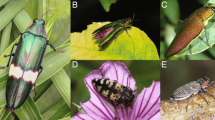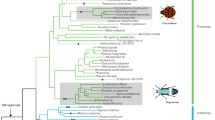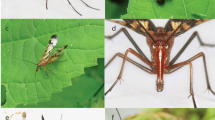Abstract
Recent large-scale studies of opsin gene contents in representatives of the largest order of insects, the Coleoptera (beetles), revealed that the blue wavelength-sensitive (B) opsin subfamily is absent in this clade, while the ultraviolet- (UV) and long wavelength-sensitive (LW) opsin subfamilies are broadly conserved with gene duplications possibly reintroducing blue sensitivity in select subclades. Little is known yet, however, how opsin genes are expressed in the compound eyes of beetles. In a previous study, we analyzed opsin gene expression in the red flour beetle Tribolium castaneum, a member of the family of darkling beetles (Tenebrionidae), and found that a singleton LW opsin homolog is homogeneously expressed in all photoreceptors of the compound eye retina with a singleton UV opsin homolog being co-expressed in the R7 subtype photoreceptors. To probe for the evolutionary conservation of these expression patterns, we isolated complete opsin transcript sequences from three additional species in the subfamily Tenebrionidae (Tribolium confusum, Tenebrio molitor, Zophobas morio) and studied their expression via whole mount in situ hybridization in the pupal retina. These experiments revealed very similar, if not identical, photoreceptor subtype-specific expression patterns in all three species compared with T. castaneum. Documenting a deep conservation of photoreceptor subtype-specific opsin gene expression in this range of darkling beetles, our study provides a first point of reference for broader comparative studies of retinal organization in the Coleoptera.


Similar content being viewed by others
References
Altschul SF, Gish W, Miller W, Myers EW, Lipman DJ (1990) Basic local alignment search tool. J Mol Biol 215:403–410
Angelini DR, Jockusch EL (2008) Relationships among pest flour beetles of the genus Tribolium (Tenebrionidae) inferred from multiple molecular markers. Mol Phylogenet Evol 46:127–141
Bouchard P, Lawrence JF, Davies AE, Newton AF (2005) Synoptic classification of the world Tenebrionidae (Insecta: Coleoptera) with a review of family-group names. Annal Zool 55:499–530
Briscoe AD, Chittka L (2001) The evolution of color vision in insects. Annu Rev Entomol 46:471–510
Castresana J (2000) Selection of conserved blocks from multiple alignments for their use in phylogenetic analysis. Mol Biol Evol 17:540–552
Condamine FL, Clapham ME, Kergoat GJ (2016) Global patterns of insect diversification: towards a reconciliation of fossil and molecular evidence? Sci Rep 6:19208
de Couet H, Tanimura T (1987) Monoclonal antibodies provide evidence that rhodopsin in the outer rhabdomeres of Drosophila melanogaster is not glycosylated. Eur J Cell Biol 44:50–56
Ferrer J (2011) Revisión del género Zophobas Dejean, 1834 (Coleoptera, Tenebrionidae, Tenebrionini). Bol Soc Entomol Aragonesa 48:287–319
Frentiu FD, Bernard GD, Cuevas CI, Sison-Mangus MP, Prudic KL, Briscoe AD (2007) Adaptive evolution of color vision as seen through the eyes of butterflies. Proc Natl Acad Sci U S A 104(Suppl 1):8634–8640
Friedrich M, Cook T, Zelhof AC (2016) Ancient default activators of terminal photoreceptor differentiation in the pancrustacean compound eye: the homeodomain transcription factors Otd and Pph13. Curr Opin Insect Sci 13:33–42
Friedrich M, Rambold I, Melzer RR (1996) The early stages of ommatidial development in the flour beetle Tribolium castaneum (Coleoptera; Tenebrionidae). Dev Genes Evol 206:136–146
Friedrich M, Wood EJ, Wu M (2011) Developmental evolution of the insect retina: insights from standardized numbering of homologous photoreceptors. J Exp Zool B Mol Dev Evol 316:484–499
Henze MJ, Oakley TH (2015) The dynamic evolutionary history of pancrustacean eyes and opsins. Integr Comp Biol 55:830–842
Jackowska M, Bao R, Liu Z et al (2007) Genomic and gene regulatory signatures of cryptozoic adaptation: loss of blue sensitive photoreceptors through expansion of long wavelength-opsin expression in the red flour beetle Tribolium castaneum. Front Zool 4:24
Kergoat GJ, Bouchard P, Clamens A-L, et al (2014a) Cretaceous environmental changes led to high extinction rates in a hyperdiverse beetle family. BMC Evol Biol 14
Kergoat GJ, Soldati L, Clamens A-L et al (2014b) Higher level molecular phylogeny of darkling beetles (Coleoptera: Tenebrionidae). Syst Entomol 39:486–499
Lord NP, Plimpton RL, Sharkey CR, Suvorov A, Lelito JP, Willardson BM, Bybee SM (2016) A cure for the blues: opsin duplication and subfunctionalization for short-wavelength sensitivity in jewel beetles (Coleoptera: Buprestidae). BMC Evol Biol 16:107
Letunic I, Bork P (2016) Interactive tree of life (iTOL) v3: an online tool for the display and annotation of phylogenetic and other trees. Nucleic Acids Res 44:242–245
Madeira F, Park YM, Lee J et al (2019) The EMBL-EBI search and sequence analysis tools APIs in 2019. Nucleic Acids Res 47:636–641
Mahato S, Morita S, Tucker AE, Liang X, Jackowska M, Friedrich M, Shiga Y, Zelhof AC (2014) Common transcriptional mechanisms for visual photoreceptor cell differentiation among Pancrustaceans. PLoS Genet 10:e1004484
Maksimovic S, Cook TA, Buschbeck EK (2009) Spatial distribution of opsin-encoding mRNAs in the tiered larval retinas of the sunburst diving beetle Thermonectus marmoratus (Coleoptera: Dytiscidae). J Exp Biol 212:3781–3794
McKenna DD, Scully ED, Pauchet Y et al (2016) Genome of the Asian longhorned beetle (Anoplophora glabripennis), a globally significant invasive species, reveals key functional and evolutionary innovations at the beetle-plant interface. Genome Biol 17:227
McKenna DD, Shin S, Ahrens D et al (2019) The evolution and genomic basis of beetle diversity. Proc Natl Acad Sci U S A 116:24729–24737
Miller MA, Pfeiffer W, Schwartz T (2010) Creating the CIPRES Science Gateway for inference of large phylogenetic trees. In: 2010 Gateway computing environments workshop (GCE). IEEE, pp 1–8
Perry M, Kinoshita M, Saldi G, Huo L, Arikawa K, Desplan C (2016) Molecular logic behind the three-way stochastic choices that expand butterfly colour vision. Nature 535:280–284
Pichaud F, Briscoe A, Desplan C (1999) Evolution of color vision. Curr Opin Neurobiol 9:622–627
Richards S, Gibbs RA, Weinstock GM et al (2008) The genome of the model beetle and pest Tribolium castaneum. Nature 452:949–955
Rister J, Razzaq A, Boodram P, Desai N, Tsanis C, Chen H, Jukam D, Desplan C (2015) Single–base pair differences in a shared motif determine differential rhodopsin expression. Science 350:1258–1261
Salamanca DA, Brown F (2018) Sub-functionalization of dorsal and ventral eyes in a whirligig beetle (Coleoptera: Gyrinidae). Neotropical Biodivers 4:138–144
Schmitt A, Vogt A, Friedmann K et al (2005) Rhodopsin patterning in central photoreceptor cells of the blowfly Calliphora vicina: cloning and characterization of Calliphora rhodopsins Rh3, Rh5 and Rh6. J Exp Biol 208:1247–1256
Schoville SD, Chen YH, Andersson MN et al (2018) A model species for agricultural pest genomics: the genome of the Colorado potato beetle, Leptinotarsa decemlineata (Coleoptera: Chrysomelidae). Sci Rep 8:1931
Sharkey CR, Fujimoto MS, Lord NP, Shin S, McKenna DD, Suvorov A, Martin GJ, Bybee SM (2017) Overcoming the loss of blue sensitivity through opsin duplication in the largest animal group, beetles. Sci Rep 7:8
Sievers F, Wilm A, Dineen D, Gibson TJ, Karplus K, Li W, Lopez R, McWilliam H, Remmert M, Söding J, Thompson JD, Higgins DG (2011) Fast, scalable generation of high-quality protein multiple sequence alignments using Clustal Omega. Mol Syst Biol 7:539
Slipinski SA, Leschen RAB, Lawrence JF (2011) Order Coleoptera Linnaeus, 1758. In: Zhang, Z.-Q.(Ed.) Animal biodiversity: an outline of higher-level classification and survey of taxonomic richness. Zootaxa 3148:203–208
Song N, Liu H-Y, Yang X-J, Zhao XC, Lin AL (2018) Complete mitochondrial genome of the darkling beetle Gonocephalum outreyi (Coleoptera: Tenebrionidae) with phylogenetic implications. J Asia Pac Entomol 21:721–730
Stamatakis A (2014) RAxML version 8: a tool for phylogenetic analysis and post-analysis of large phylogenies. Bioinformatics 30:1312–1313
Wakakuwa M, Kurasawa M, Giurfa M, Arikawa K (2005) Spectral heterogeneity of honeybee ommatidia. Naturwissenschaften 92:464–467
Wakakuwa M, Terakita A, Koyanagi M, Stavenga DG, Shichida Y, Arikawa K (2010) Evolution and mechanism of spectral tuning of blue-absorbing visual pigments in butterflies. PLoS One 5:e15015
Wernet MF, Perry MW, Desplan C (2015) The evolutionary diversity of insect retinal mosaics: common design principles and emerging molecular logic. Trends Genet 31:316–328
Wolff T, Ready DF (1991) The beginning of pattern formation in the Drosophila compound eye: the morphogenetic furrow and the second mitotic wave. Development 113:841–850
Yinon U (1970) The visual mechanisms of Tenebrio molitor: some aspects of the spectral response. J Exp Biol 53:221–229
Wu M (2008) Evolutionary analysis of opsin genes in Tribolium and related darkling beetles. Wayne State University, Master of Science
Zhang S-Q, Che L-H, Li Y, Dan Liang, Pang H, Ślipiński A, Zhang P (2018) Evolutionary history of Coleoptera revealed by extensive sampling of genes and species. Nat Commun 9:205
Acknowledgments
We thank Sue Brown and Michael Wade for providing T. confusum and Camilla Sharkey and the three anonymous reviewers for their helpful comments on the manuscript.
Author information
Authors and Affiliations
Corresponding author
Additional information
Communicated by Nico Posnien
Publisher’s note
Springer Nature remains neutral with regard to jurisdictional claims in published maps and institutional affiliations.
Electronic supplementary material
ESM 1
(DOCX 9 kb)
ESM 2
(DOCX 9 kb)
ESM 3
(DOCX 8 kb)
ESM 4
Multiple protein sequence alignments of UV- and LW opsin homologs (PPTX 66 kb)
ESM 5
Maximum likelihood gene tree analysis of the newly isolated tenebrionid UV- and LW opsin homologs. Numbers at branches indicate non-parametric bootstrap branch support values. Species abbreviations: Amel = Apis mellifera, Tcas = T. castaneum, Tcon = T. confusum, Tmol = T. molitor, Zmor = Z. morio. Scale bar corresponds to 0.1 substitutions per site. (DOCX 12 kb)
ESM 6
Comparison of body lengths, thorax widths, and eye sizes (XLSX 5 kb)
Rights and permissions
About this article
Cite this article
Wu, M., Bao, R. & Friedrich, M. Evolutionary conservation of opsin gene expression patterns in the compound eyes of darkling beetles. Dev Genes Evol 230, 339–345 (2020). https://doi.org/10.1007/s00427-020-00669-2
Received:
Accepted:
Published:
Issue Date:
DOI: https://doi.org/10.1007/s00427-020-00669-2




